*This post was previously live on my other site TheWingedFork.com
Latin American churches are truly in a league all their own. Whether you visit South or Central America, you’ll find some of the most beautiful churches in Latin America in many villages or towns.
Who built the churches in colonial South America and Central America? Most of the catholic churches in South America and Central America were built by Spanish missionaries in the 1500s, while the Portuguese and the French followed suite.
And the magnificence and splendour of these cathedrals and churches are a testament to the good and the bad of the Age of Discovery. But that’s a story for another day!
Many of the beautiful churches in Latin America are as awe-inspiring as the churches in Europe or other parts of the world. Here are the top Latin American churches to visit.
1. Cathedral of the Virgin Mary of the Immaculate Conception or Cathedral of Havana in Havana, Cuba
By Talek from Travel with Talek

The Cathedral of the Virgin Mary of the Immaculate Conception is the official name of what is commonly referred to as the Cathedral of Havana.
This baroque-style church sits in the center of Cathedral Plaza, one of four principle plazas in the old part of Havana. As the Spanish settlers converted more and more of the local natives to Christianity, it became necessary to build churches. After much petitioning the King of Spain, construction of the church was finally approved.
Construction dates from the middle of the 1700s and was originally built on a drained swamp. The left bell tower is narrower than the right. It was designed that way so water would drain off the church into the ocean rather than flooding the plaza.
As a result, the church can lay claim to being the only structure in existence with such an asymmetrical feature.
Today this graceful church serves as the seat of the Archbishop of Havana and a major tourist draw. All around it are the well-preserved examples of Spanish colonial architecture.
Also nearby are famous restaurants including one frequented by Hemingway, art galleries and the elegant Museum of the City of Havana.
Here’s another take on the Havana Cathedral or Catedral de San Cristobal in Havana, Cuba
By Jarrod from Ramble Around The World

The Havana Cathedral, commonly known as the Catedral de San Cristobal, is one of the oldest churches in the Caribbean, dating back to 1748 and completed entirely in 1777. The cathedral was erected in large part to the Spanish explorer Christopher Columbus, who arrived in Havana with the intent to colonize the island to Spanish control.
Even though the Cathedral was built centuries after Columbus passed, he played such a huge role in the construction of it that his remains were kept inside from 1796 to 1898.
The Catedral de San Cristobal sits as the centerpiece in the four squares of Havana, still holding religious ceremonies each day as well as being open to visitors.
It’s an extremely beautiful structure crafted from all-natural coral stone in a Baroque style, standing 160 feet high with large symmetrical bell towers on either side.
Its interior with vaulted ceilings project the speaker’s voice without the need for modern technology, which was extremely helpful in the 18th century when the cathedral was regularly visited by more than 25,000 people per session.
2. Bonfim Church in Salvador, Brazil
By Thais from World Trip Dairies

The church of Nosso Senhor do Bonfim, or just Igreja do Bonfim, is in the peninsula of Itapagipe, in Salvador (Bahia, Brazil). It was open in 1754 and still preserves a lot of its original beauty.
Every year, in January, they have a massive celebration called Festa do Bonfim, where the church’s stairs are washed and there is music, culture, tradition, and faith.
It’s one of the many Catholic churches in Salvador (the city has over 300 of them!) but what makes it stand out (besides from its history and its beauty) are the gates. The gates all around the church are covered in colorful ribons, tied by the visitors.
They are said to make a wish come true and are very popular. You can buy them from street vendors all around the church or on the souvenir or religious items shops in the neighborhood. Make your wish as you tie a ribbon to the gate, then make another wish and tie one to your wrist. When the ribbon breaks (you can’t force it, though), your wish should come true!
3.The Salt Cathedral of Zipaquirá: Colombia’s Underground Church
By Danielle & John from Two for the World

Step into the sweeping central chamber of Colombia’s Salt Cathedral of Zipaquirá, and you’ll spy the hallmarks of a classic Catholic church: soaring columns, rows of wooden pews, a stone altar backed by a high cross.
This minster though, is unlike any other you’ll visit. For one thing, it’s hewn straight from the halite rock of an ancient mountain. It’s also 200-metres underground.
People have been mining rock salt from the Zipaquirá foothills, an hour north of Bogotá, for millennia. The perilous work led miners to carve a small chapel underground in the 1930s, where they could pray for safety. Today’s vast cathedral was quarried sixty years later.
Symbolism buttresses this sacred complex. Touring Zipaquirá Salt Cathedral with a guide, you’ll pass 14 low-lit stone chapels – stations of the cross – before arriving under a wide, glowing dome.
A labyrinthine stairway descends to the cathedral itself: three rock-hewn chambers representing birth, life and death. A monumental cross illuminates the central nave, a cleverly-carved optical illusion.
This subterranean marvel is a functioning Catholic church, with Sunday services. Visit any day though; if you’re looking for things to do in Bogotá, the rock-solid grandeur of this singular cathedral-under-the-mountain is a must-see.
4. Sanctuary of Atotonilco, near San Miguel de Allende, Mexico, UNESCO World Heritage site
By Donna from Nomad Women

Just 8 miles (14 km) from the colonial town of San Miguel de Allende, in central Mexico, is a church amazing enough to be nicknamed “The Sistine Chapel of Mexico.”
The Santuario de Atotonilco looks like a simple Mexican church from the outside, with unadorned high white walls and a dome.
But walk through the doors and you enter into a mad celebration of blood and baroque. Nearly every surface of the interior is covered in exuberant murals. Phantasms and angels, bleeding penitents and pilgrims, mythical animals and flowers swirl over the ceilings, arches and walls in a visual frenzy.
The church was begun in 1740 and took 35 years to complete. The murals, relating an exaggerated vision of the life of Christ, were painted by a local artist in the “folk baroque” style.
The murals are augmented by statues, pillars, mirrors and gilt. Taken together, the effect is dizzy-making as you wander the aisles craning your neck to take it all in.
Years of damp and neglect took their toll, threatening to damage the murals beyond repair. But in 1996, the World Monuments Fund spear-headed a drive to restore the endangered sanctuary.
The result is a cleaned and stabilized work of art. In 2008, The Santuario de Atotonilco was named a UNESCO World Heritage Site.
5. El Santuario de las Lajas, Colombia
By Claire of Tales of a Backpacker

This stunning church is in the south of Colombia, close to the border with Ecuador. What makes this church special is that it is built on a bridge 130 feet above the Guaitara river, in a feat of engineering and beauty.
There has been a shrine on this site since the mid-1700s when a local woman and her deaf-mute daughter were sheltering from a storm and saw an image of the Virgin Mary on one of the slate rocks (known as lajas) found on the mountainside.
Since then, a church was built around the shrine, gradually being expanded over the years. The spectacular building that stands here today was completed in 1949 and is one of the world’s most beautiful churches.
El Santuario de las Lajas in Colombia is definitely worth a detour if you are crossing the border between Colombia and Ecuador by land, there are shared taxis which go from Ipiales bus station close to the border to the church.
Take time to go inside the church, and walk up the surrounding paths. You can also take a trip on the cable car across the valley for incredible views of the church from above.
Related Post
Amazing Churches in the US that you must visit at least once!
6. Iglesia de San Pedro, Andahuaylilas, Peru
By Heather from Conversant Traveller
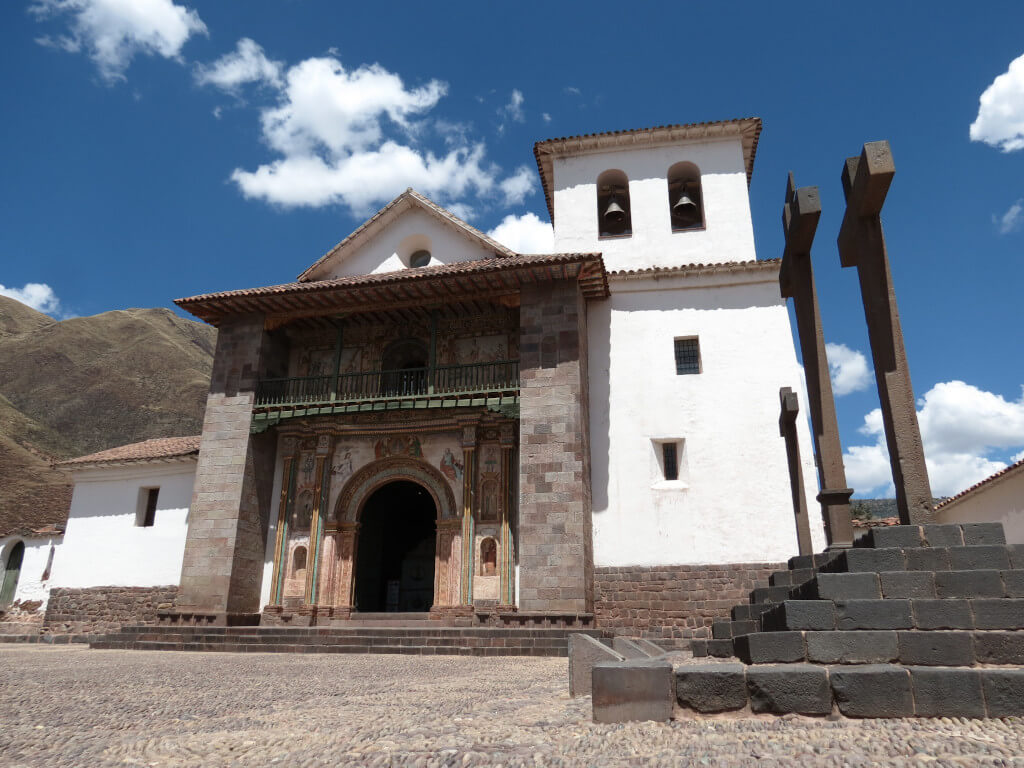
Sometimes it’s the remote and humble churches that surprise us the most. We came across the quaint Andean village of Andahuaylilas whilst visiting the nearby ruins of Tipon and Pikillacta on a day trip from Cusco.
At the centre of the tiny settlement we found a sleepy square lined with flowering trees, and a small unassuming church that was clearly the focal point of the community.
This 16th century church was built by the Jesuits and today is known as the ‘Sistine Chapel of the Andes’ thanks to the incredible painted murals that adorn the walls and ceiling inside.
There are gold and silver artefacts, as well as golden alters, and the gleaming opulence is breath-taking, more in keeping with the grand cathedral in Cusco than a quiet backwater countryside church.
The church is now a UNESCO World Heritage Site thanks to the painstaking restoration process instigated by the proud guardian some 20 years ago. Thanks to its remote location this Andean gem remains uncrowded and when we went we were the only visitors there!
7. Basílica de María Auxiliadora y San Carlos in Buenos Aires, Argentina
By Erin from Sol Salute
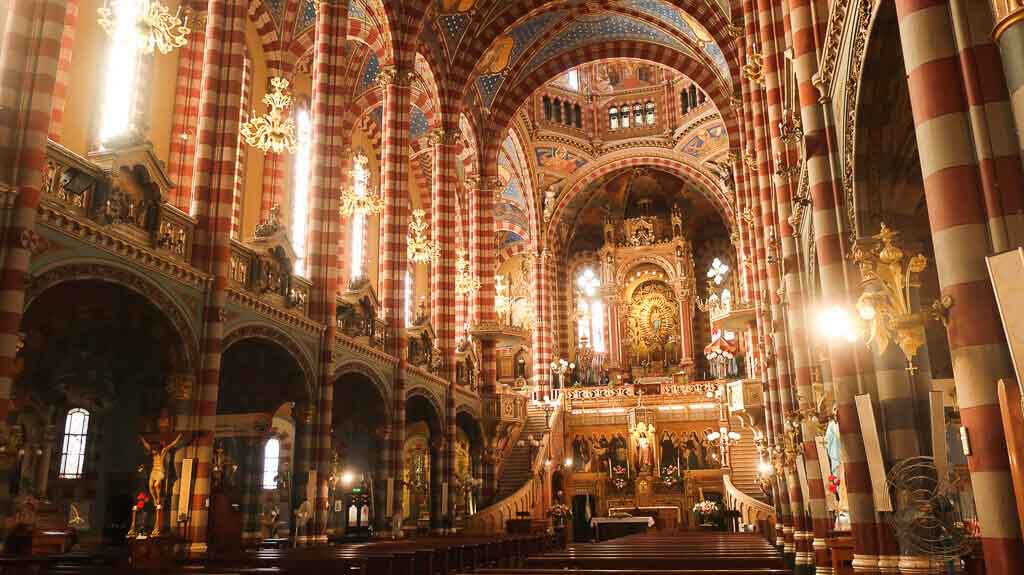
The most beautiful church in Buenos Aires is hidden away in the residential neighborhood of Almagro. It’s far off the tourist’s beaten path and honestly, not even many locals know about it.
The Basílica María Auxiliadora y San Carlos was constructed in less than ten years from 1900 to 1910. It’s of the Romanic Lombardic style and the beauty is impactful.
The red and white columns are almost candy-cane like and are reminiscent of the columns in the mosque of Cordoba in Spain. The ceiling is a rich blue, decorated with stars and copious amounts of gold that add a regal feel to an already opulent basilica.
This church has had its fair share of famous parishioners. Pope Francis was baptized here in 1936 and as Archbishop Bergoglio he performed religious ceremonies here on multiple occasions.
This neighborhood was his own (he’s even a fan of the Almagro football team!). Carlos Gardel, the world’s most famous tango star, got his start as a child in the María Auxiliadora’s choir.
This basilica is open for visitors but operates on a very strict schedule. It’s open in the morning from 7:30-12, and again in the evening from 5:30-8:30. I recommend visiting in the afternoon to catch the day’s final rays of sun beaming in through the ornate windows.
8. Sao Francisco Church and Convent in Salvador de Bahia, Brazil
By Moheb, The Wanderer Pharoah

Sao Francisco Church and Convent lies in the Pelourinho, the historic centre of Salvador de Bahia, in the north-east of Brazil.
The original church was built on the same site by the Franciscans around 1587. But it was destroyed during the Dutch invasion in the 17th century. So, the modern Sao Francisco Church and Convent construction began in 1686.
Sao Francisco Church and Convent is one of the Seven Wonders of Portuguese Origin in the World and a UNESCO World Heritage Site.
The Church is decorated by an outstanding artwork. The walls, the pilasters and the church’s eight columns were made from Bahian sandstone. Also, the inner walls and ceilings are covered in golden artwork and paintings.
The Location of Sao Francisco Church and Convent, in Pelourinho, increased its significance and beauty. Although Pelourinho was the whipping post for slaves in the Portuguese colonial era, it is now the heart of Salvador.
Pelourinho is the place you go to enjoy the Afro-Brazilian culture with its lively music and traditional dances and street food.
9. Cathedral of Brasília in Brazil
By Ingrid from Second-Half Travels

Brasília, Brazil’s unique capital, achieved UNESCO World Heritage status due to its monumental modernist architecture and innovative urban design.
The Cathedral of Brasília, or Catedral Metropolitana de Brasília in Portuguese, is a must-see when visiting this fascinating planned city.
The cathedral is located on the city’s famed Monumental Axis. It’s in walking distance of many other acclaimed architectural landmarks such as the Square of the Three Powers and the National Theater.
The cathedral was designed by celebrated Brazilian architect Oscar Niemeyer, whose stunning space-age buildings fill Brasília. Many consider this place of worship to be Niemeyer’s finest achievement.
The Roman Catholic cathedral was completed in 1970. Both the interior and exterior of the building are striking. It’s constructed of 16 gracefully curved concrete columns. The shape is intended to evoke a crown of thorns.
A 12-meter reflecting pool surrounds the cathedral. Visitors enter through a dark subterranean passage and emerge into a light-filled space surrounded by a kaleidoscope of colorful stained glass. The interior holds 4,000 people.
Floating sculptures of three angels are suspended over the nave by steel cables.
It’s worth visiting at night to admire the cathedral’s spectacular illumination and reflection in the pool surrounding it.
10. Cathedral of Leon in Nicaragua
By Claudia from My Adventures Across The World
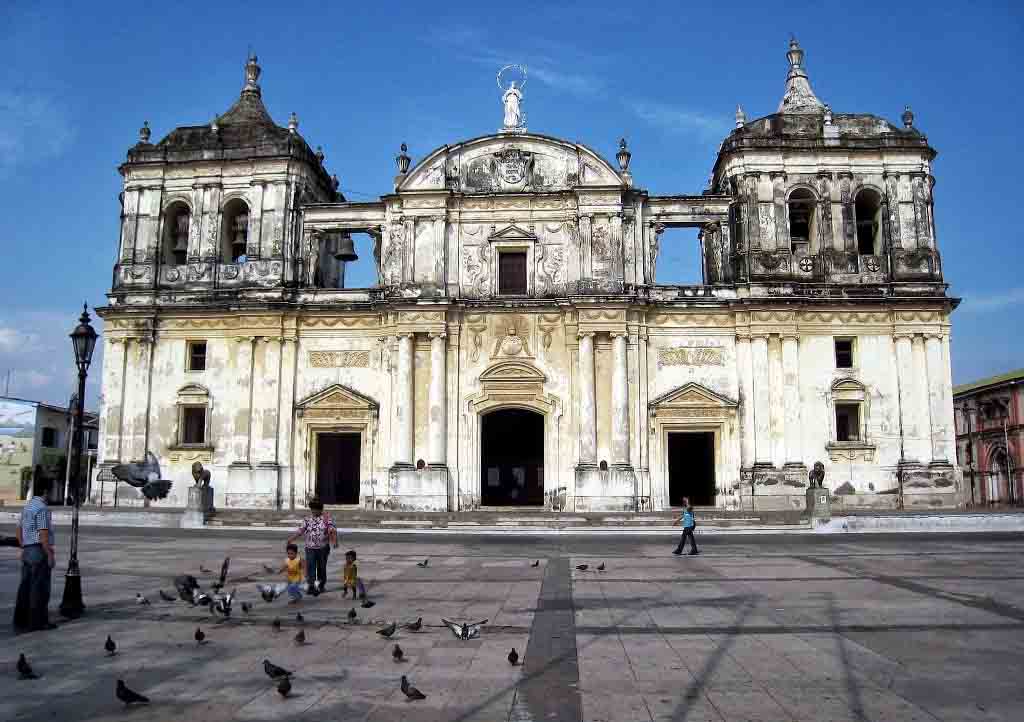
If you think of Nicaragua, your mind usually goes to the many volcanoes and the beautiful beaches perfect for learning how to surf.
What many don’t know is that this country has a glorious colonial past and indeed, one of the best things to do in Nicaragua, is exploring the many beautiful churches.
One of the best-kept ones is Leon Cathedral, which is currently the largest Cathedral in Central America. According to history, it was built following a plan that was meant to be for the Cathedral of Lima, in Peru.
The church is located in the Parque Central – Leon main square and if you do visit the city, you will be tempted to walk in more than once as it is a great respite from the terrible heat of the city.
The Cathedral is the burial ground of Ruben Darío, the most famous poet of Nicaragua. One of the most fun things to do inside is going in search of the 7 hidden eyes.
These are just triangles that contain an eye inside and which are all hidden among the artwork of the church – in the walls and the ceiling.
This famous Central American Church is open Mondays to Saturdays from 8:00 am to 12:00 pm and from 2:00 to 4:00 pm. It is only open for service on Sunday.
Related Post
Beautiful Churches in Africa to Visit
11. Metropolitan Cathedral of Saint Sebastian in Rio de Janeiro, Brazil
By Norbert from GloboTreks

The Metropolitan Cathedral of Saint Sebastian in Rio de Janeiro, Brazil, is probably one of the most underrated buildings in this beachside destination.
Located in the city center, just a few minutes walking north of the popular Carioca Aqueduct (Arcos Da Lapa) and the Selarón Steps, the Saint Sebastian Cathedral is often skipped by unsuspecting tourists. But, it’s worth a quick peek.
Often referred to as the New Cathedral, the church is dedicated to Saint Sebastian, the patron saint of Rio de Janeiro, and was built between 1964 and 1979 to become the seat of the Archdiocese and replace a series of churches that had served as cathedrals since 1676.
Among the replaced cathedrals was the historic Church of Our Lady of Mount Carmel of the Ancient See -now known as the Old Cathedral- built in the 18th century, and declared Rio’s cathedral in the early 19th century.
The beloved Old Cathedral was also used as the Royal and Imperial Chapel by the Portuguese Royal Family and the Brazilian Imperial Family during the 19th century.
Edgar de Oliveira da Fonseca designed the church in a modern conical style, based on the Mayan pyramids – even when Brazil has no Mayan history.
But, besides its unique shape, one of the most striking features of the church are the four rectilinear stained glass windows that soar 210 feet from floor to ceiling. When seen from the entrance, they form a colorful cross beautifully lit from the sky.
Here’s another take on the Cathedral of Rio de Janeiro
By Chrysoula from Travel Passionate

The Cathedral of Rio de Janeiro, also known as The Metropolitan Cathedral of Saint Sebastian is a huge Catholic cathedral located in the heart of the capital that is quite unlike most other Catholic churches.
This modern cathedral, built between 1964 and 1979, features a conical shape (similar to that of Mayan Pyramids) and is steeped in religious symbolism.
The towering structure, standing at 75m in height features a flat, circular top which is said to represent the closeness of people to God, and a bright cross-shaped ceiling which floods the church with light and is thought to portray the light of God spreading down towards the people.
There are also four intricate stained-glass windows running the height of the building and a Sacred Art Museum located in the basement.
The Catedral Metropolitana do Rio de Janeiro has the capacity to host up to 20,000 people standing (or 5000 seated) which it did for the “Second World Meeting of the Pope with Families” when His Holiness Pope John Paul II presided over a ceremony here in 1980.
The Metropolitan Cathedral is free to visit and is open daily from 7am to 5pm and is a must-see on any Rio itinerary.
12. Church of Polloc in Encañada, Cajamarca, Peru
By Anthony & Anna of Green Mochilla
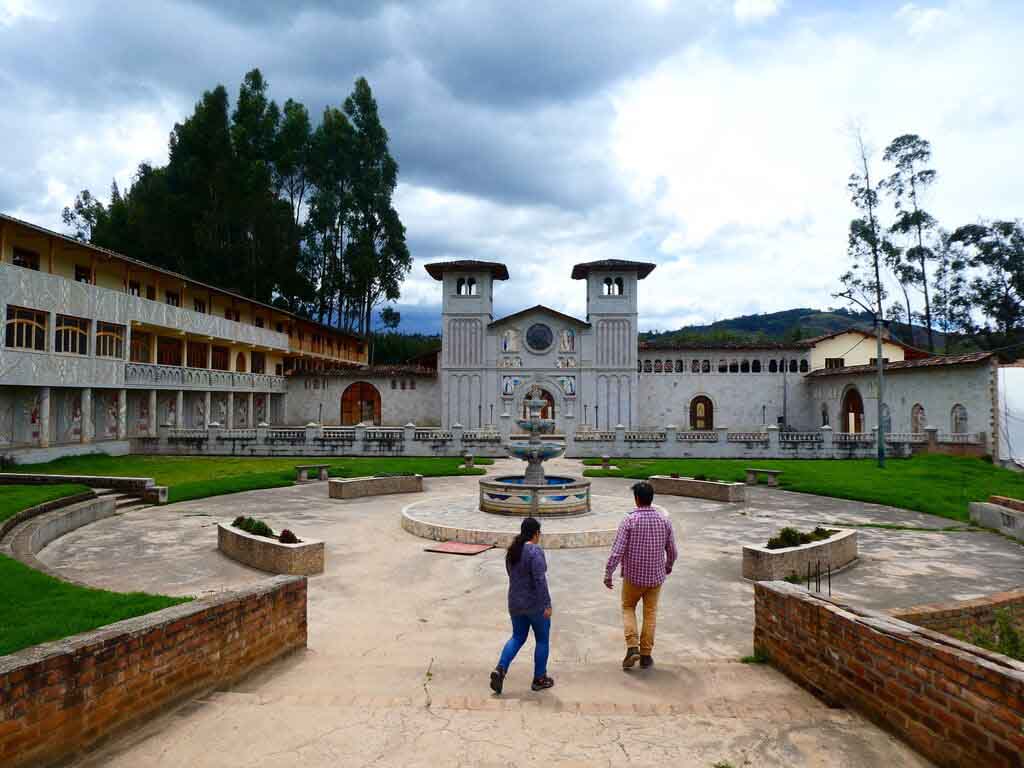
Let’s be honest, travelling off-the-beaten path isn’t always exciting. There’s a good reason famous places got famous; unfortunately, there’s sometimes a very good reason other places are overlooked.
Travelling in the north of Peru is already a provocation. The South of the country attracts most visitors all year round with its bucket-list items: Machu Picchu, Cusco, Lake Titicaca.
But you don’t get to know a country by visiting only half of it; so up we went and we spent two days in the pretty, although completely off-the-radar, colonial town of Cajamarca.
That per se is already a pat-on-the-back-worthy feat. Cajamarca is a small, cosy town with a chilled atmosphere and beautiful churches. But thanks to our host, his knowledge and his car, we went further off-road and were in for a gorgeous surprise.
A 1-hour drive from Cajamarca lies the nondescript village of Polloc. It would remain unnoticed if it wasn’t for the sumptuous modern church on its outskirt, completely covered in mosaics –outside and inside– by the children of the village.
The inside offers a cool and serene haven with its gigantic artworks, while the outdoor patio is green and peaceful. Perfect for either meditating or observing the mosaics, it really brings everyone together.
No, travelling off-the-beaten path isn’t always exciting. But as long as we’ll find hidden gems like the Church of Polloc, we’ll be sure to give it a go!
13. Primatial Cathedral of Bogotá, Colombia
By Emily from Wander-Lush

All roads in Bogota lead to Plaza Bolívar, the massive open square where Colombians have been gathering to trade, socialise and celebrate for centuries.
The plaza is ringed by impressive facades, but none is more noteworthy than that of the Cathedral Basilica Metropolitan & Primate of the Immaculate Conception & Saint Peter of Bogotá – better known as the Primatial Cathedral of Bogotá.
The capital’s most important church serves as the seat of the Archbishop. Paying pilgrimage is a must-do in Bogota.
The twin towers that stand today are in fact the church’s fourth iteration – a house of worship was first constructed on this site in the 1550s. Back then, it took the form of a modest chapel with a thatched roof.
Earthquakes destroyed two subsequent designs until finally a group of Jesuit missionaries constructed a new church that could withstand the elements.
Work on the cathedral you see today commenced in 1807 and was completed 16 years later when Colombia was no longer under the yoke of Spanish colonial rule.
As you enter through the cathedral’s heavy wooden doors, the elegant white interior is a slave for the chaos of the square outside. Vaulted ceilings in a palette of caramel and cream, chandeliers and gold-tipped columns complete the design.
14. San Francisco Basilica and Convent in Lima, Peru
By Clotilde, A Princess Travelling With Twins
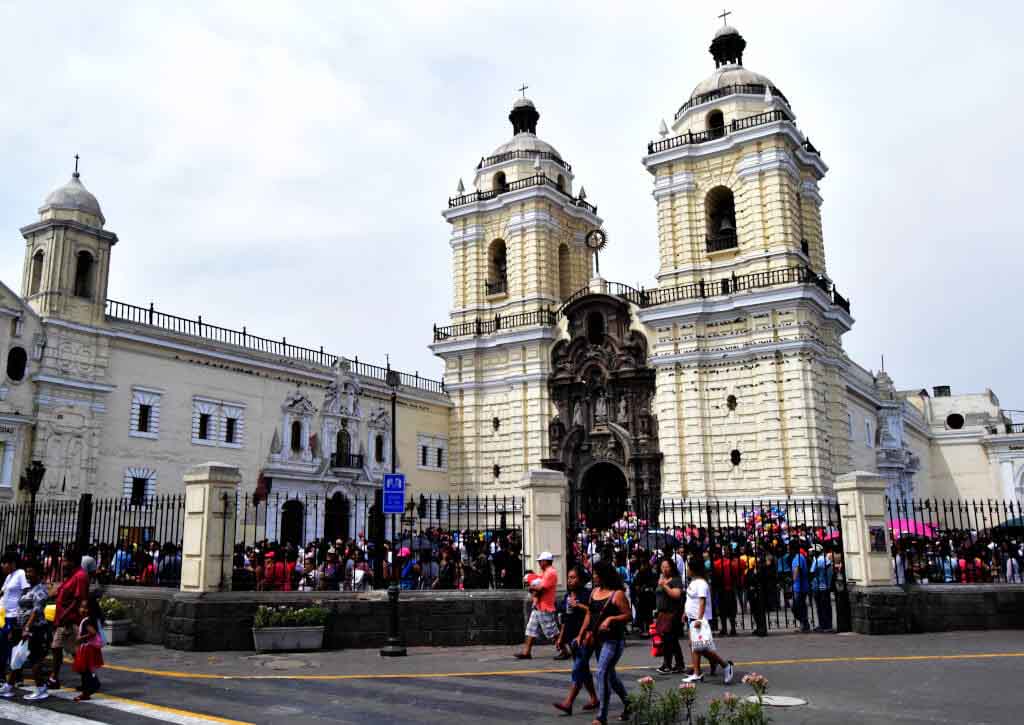
The San Francisco Basilica and Convent is a large monastic complex of the 12th century which includes the basilica, convent, library, the catacombs in the basement, and two smaller chapels.
Found in the historic center of Lima, it is close to the Plaza de Armas and the Cathedral, in a perfect location for a pleasant stroll through the often under rated historical center of Lima in Peru (inscribed on the UNESCO list).
The courtyard, from which you can admire the white and yellow colonial facade of the church, gives access to the church itself and then to the rest of the complex which can only be accessed with a guided tour.
Of particular importance are, a library on the first floor that houses various rare editions and more than 25,000 volumes from the colonial era, and in the basement a visit to the network of tunnels used as catacombs where thousands were buried before the construction of the current cemetery around 1821. Nowadays only the Friars of the Franciscan order may be buried here in a crypt closed to the public.
For a modest entry fee, you can spend about 45-50 minutes in this fascinating and beautiful jewel of colonial art.
15. Parroquia de San Miguel Arcángel, Guanajuato, Mexico
By Brittany of Bucketlist Bri

The pink-spire baroque church in San Miguel de Allende (Parroquia de San Miguel Arcángel) located in the state of Guanajuato, Mexico is the most-photographed church in all of Mexico, attracting thousands of tourists every day.
The San Miguel de Allende church is a marvel to look at. Plus, it’s history is fascinating too! The city itself grew out of its former state – a small indigenous village known as Izcuinapan. It was Spanish settler Juan de San Miguel who is credited for naming the city after the Archangel Michael.
Jump ahead to the 20th century, the global influenza pandemic nearly made what’s now San Miguel de Allende into a ghost town. At least until artists came to the city and began opening up art schools which eventually attracted more artists, some famous, who sparked an international wave of tourism.
The city was named a UNESCO World Heritage Site in the early 1980s and now features statues of its founders around the historic zone, with a statue of the Archangel Michael placed in the central plaza directly opposite the San Miguel parish.
The San Miguel de Allende church and its fairytale pink spires are what make the city of San Miguel de Allende such a popular place to visit in Mexico. Now, San Miguel de Allende is a multicultural hub of artists, writers, painters, expats, and retirees!
Related Post
Best Australian Churches to Visit
16. La Compañía de Jesús in Cusco, Peru
By Mal of Raw Mal Roams
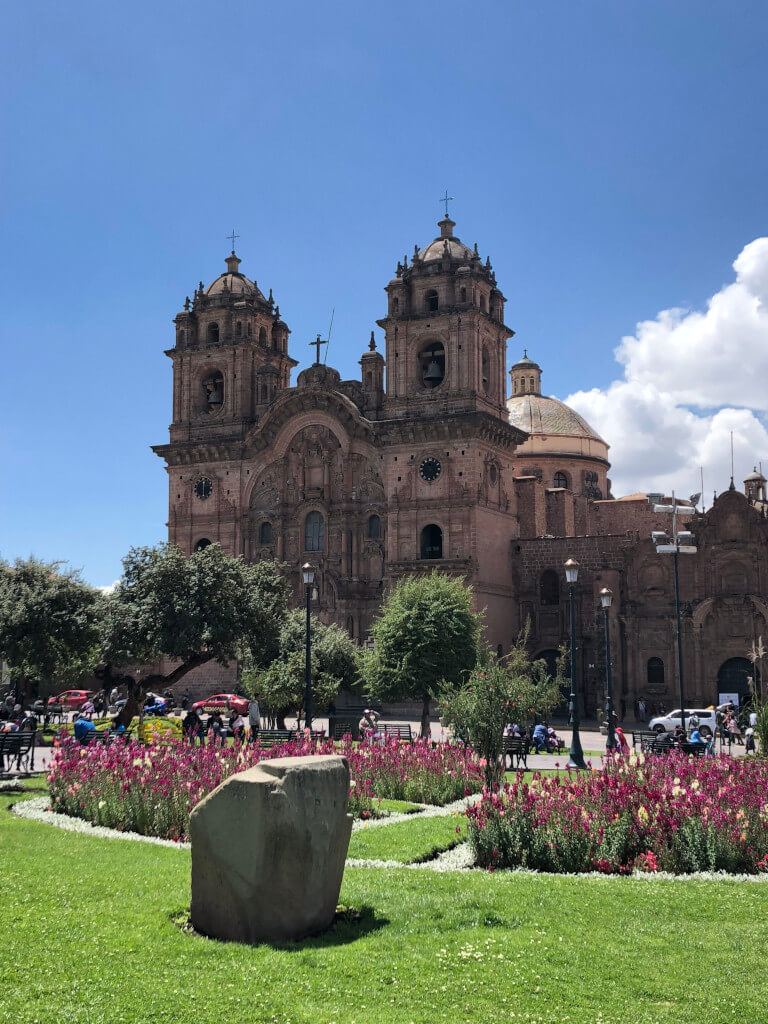
One of the top South American churches, this mesmerising Church of the Society of Jesus is located on a charming square in central Cusco called Plaza de Armas across the street from Cusco Cathedral.
The square has beautifully manicured flower beds and green lawn, and it’s a treat to just sit on one of the benches and take in the view of this stunning structure.
The church was built in the 17th century atop demolished Inca palace of the Huaya Capac called “Amarucancha”, and it’s a prime example of Spanish Baroque architecture in Peru.
Before Spanish invasion, Cusco was the capital of Inca empire and for that reason the city was a target of Spanish revisionist architecture. If you want to find out more during your visit, hire a guide that will put meaning to things you’ll see in the church.
The church has two towers and a richly decorated stone façade and two adjoining chapels. When you venture inside, you’ll see an expansive altar carved in wood and covered with gold leaf.
The incredible amount of gold that is covering the altar was stolen from the Incas. There is an impressive collection of some beautiful artwork, painting, sculptures and murals, including the Lat Supper. The church also has a pretty garden to explore.
17. Catedral Metropolitana in Zocalo, Mexico City, Mexico
By Shelley of Travel Mexico Solo
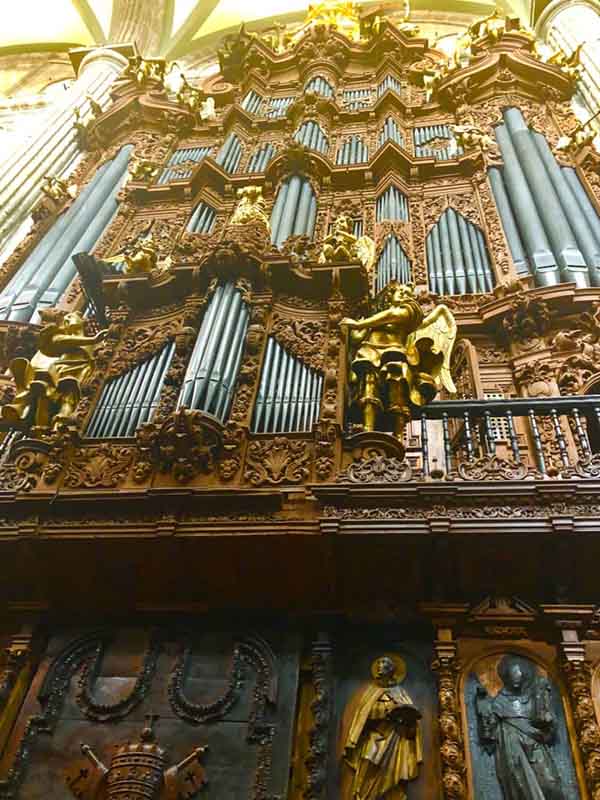
Mexico has no shortage of beautiful churches to see, though none more grand than the Catedral Metropolitana in Mexico City’s Zocalo.
Zocalo basically means “town square,” and this is the part of Mexico City where you’ll find its most famous and historic buildings. In fact, Mexico City’s entire Centro Historico (Historic City Center) is a UNESCO World Heritage Site, and in the dead center of Centro Historico is where you’ll find the zocalo.
Taking up one entire side of the zocalo square’s four sides, is the 450-feet-long/120m Catedral Metropolitana. Of all Mexico City’s many churches, this cathedral is the most opulent. This three-story church also houses two of the largest pipe organs on the Americas Continent.
The Catedral Metropolitana, ornate both inside and outside, took almost 250 years to complete. As a result of the construction spanning so much time, from 1573-1813, the church’s architectural and esthetic styles vary greatly to reflect the changes in trends throughout the years of construction.
Architects, painters and sculptors built the Catedral Metropolitana in styles including Gothic, Baroque, Neoclassical and Churrigueresque, an esthetic trend popular mostly in 17th-century Spain.
No visit to Mexico City would be complete without strolling the streets of the Centro Historico.
This bustling neighborhood is a visual representation of old-world-meets-new-world in one of the largest cities on the planet. While in Centro Historico, head to the zocalo to see the beautiful Catedral Metropolitana.
If you’re looking for churches from Europe, the list is here. Here are the list of churches you must visit in Asia, churches in Africa, and the list of churches in Australia. Happy reading!
And a PS! If you’re a travel or lifestyle blogger who has a church you want to add to this list, please ping me at abby@abbyshearth.com
Other Fun Stuff To Plan Your Adventures
- Amazing Churches to visit in America
- Australian Churches to Visit
- Machu Picchu visit
- African Cathedrals and Churches you can’t miss
- Tung Fort in Maharashtra



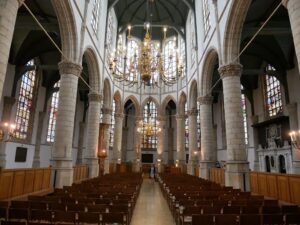
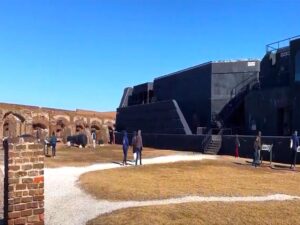
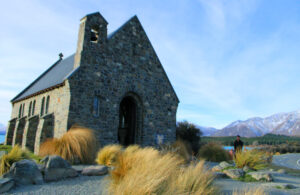


I really enjoyed reading your article about the best Latin American churches. You have a great eye for detail and a captivating writing style. I especially liked how you described the history and architecture of each church, as well as the cultural and religious significance they have for the local people. I appreciate the photos you included in your article.
Surprising that many significant churches in Quito were left out?
Hi Miguel, this list was put together based on traveller suggestions with their original photos. Which churches in Quito do you think should be on here? The Basilica of course. Which others? We’ll add them in. Or if you want to contribute some info about your favorite church, ping me at abby@abbyshearth.com with some text and an original photo and maybe I’ll add it to the list. 🙂